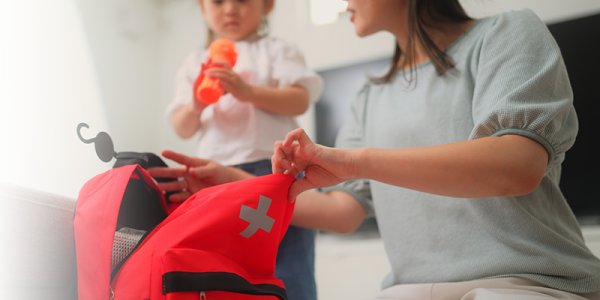
Tornados in the Midwest. Hurricanes in the South. Snow and ice storms in the North. And of course, earthquakes, mudslides, fires, and floods right here in California. No matter where you live, it’s a good idea to be prepared with a bug-out bag packed and ready to go.
Read on for a list of essentials to help you master disaster.
Skip
Begin with the Bag
Choose a large, sturdy bag that can hold the essentials but is light enough to grab on the run. If you are unable to carry a large backpack, a duffel bag on wheels is a good option. Store your kit items in airtight plastic bags in case the go-bag gets wet. Keep your go-bag where it’s easy to grab quickly, such as the front hall closet or garage.
What to Pack
The items you might need can vary widely, but this list should help you plan for the essentials.
- Water for drinking and sanitation. Figure one gallon per person per day. Travel filters that convert a local water source into drinkable water are available at many athletic supply stores.
- Non-perishable food, such as protein bars, instant oatmeal, jerky, peanut butter, nuts and seeds. If you pack canned food, don’t forget a can opener.
- A first aid kit can be purchased fully stocked. Check the kit for the following items and supplement as needed: surgical gloves, soap or hand sanitizer, moist towelettes, bandages, tape, gauze, alcohol and antiseptic pads, scissors, tweezers, and eye wash.
- Medication. If there is a possible evacuation warning, call your pharmacy and request an extra refill for your prescriptions. Pack a list of your prescriptions and contact information for your pharmacy and physicians. Consider packing some over the counter medications such as pain relievers, anti-diarrhea medication, antacids and laxatives.
- Portable medical equipment. if someone in your household has special medical needs, invest in portable equipment, such as a CPAP machine or oxygen tank. Pack syringes if needed. If you must evacuate without notice, the Rx Open website maps the pharmacies that are open in disaster-stricken areas. Please note that the website is only functional during times of disasters or when pharmacy access is significantly disrupted.
- An extra pair of prescription eyeglasses or contact lenses and solution.
- Baby supplies such as bottles, diapers, wipes and diaper rash cream.
- Battery-powered or hand crank radio and a NOAA Emergency Weather Alert Radio.
- Flashlight with extra batteries.
- Matches in a waterproof container or a lighter.
- Cell phone with chargers (consider adding a solar charger) and a backup battery.
- Cash - $200 -$500 in small bills is a reasonable amount since you may not be able to use your debit card. Consider a roll of quarters in case you need to buy food or water from vending machines.
- Personal essentials, including toothbrushes and toothpaste, feminine hygiene items and travel-size toiletries.
- A change of clothing, or at least some clean underwear and socks. Make sure you’re wearing sturdy shoes.
- N-95 masks to filter contaminated air and protect people with asthma and other respiratory issues.
- Towel and a warm blanket.
- Pet supplies – make sure your pet is microchipped and wearing their ID tag and a sturdy leash. Factor them into the amount of water you pack and bring a bowl, as well as food for a week.
- Whistle to signal for help.
- Copies of essential documents in a waterproof, ziplocked bag, including passports; birth certificates; driver’s licenses; Social Security and Medicare cards; marriage, adoption and naturalization certificates; title or lease documents; insurance paperwork; bank records; and credit and debit card information. Include a copy of your family’s emergency contact sheet.
- Mess kits, paper cups, plates, paper towels and plastic utensils.
- Notebook and pencil.
- Books and games or puzzles to keep kids entertained.
Depending on the circumstances and where you live, you might want to also include the following items:
- Shelter supplies in case you need to shelter in place, including plastic sheeting, scissors, rope, and duct tape.
- Garbage bags and plastic ties for waste.
- Tools - Bring a manual can opener and utility knife. A good multipurpose option is the Ready America Mult-Function Pocket Tool. This ten-function tool includes screwdrivers, pliers, file, wire snip, bottle opener, and a knife, all in one.
- Backup vehicle starter
- Camping lantern
- Camping stove, cutting board, and clean knives
- Portable valuables, such as jewelry and hard drives with important information on them.
Where to Find Shelter
Familiarize yourself with the emergency shelters in your area, in advance, by visiting Aidteam.org. you can search for a nearby shelter by zip code.
In conclusion, being prepared for emergencies with a well-stocked go-bag can make a significant difference in ensuring your safety and well-being during unexpected disasters. By taking the time to gather essential items and store them in a readily accessible location, you can face emergencies with greater confidence and peace of mind. Remember, the key to effective preparedness is not just having the right supplies, but also knowing how to use them and where to find shelter if needed. Stay informed, stay prepared, and stay safe.
This article first appeared in the January 2025 edition of the HealthPerks newsletter.

